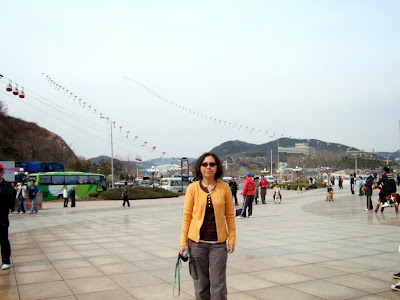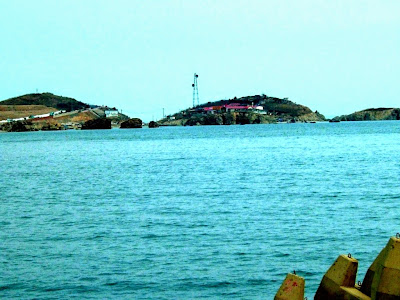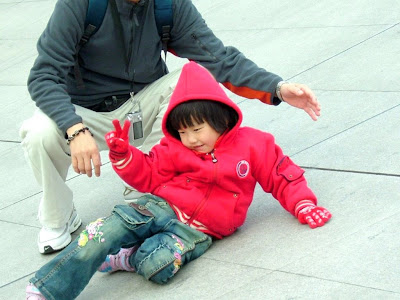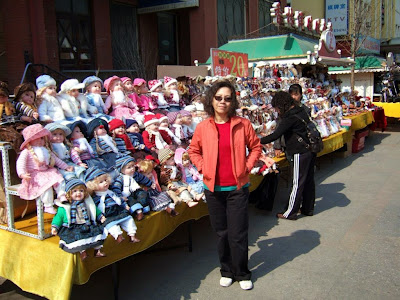
Jingshan Park (景山公园) is within a walking distance from Tiananmen, locating at northern side of Forbidden City on the central axis of Beijing. It is originally an imperial garden built in 17th century. The artificial hill has 5 peaks at an average height of 46 meters and the garden covers an area of about 0.23 sq km. We visited this garden few years ago in the month of April when peony was blooming in its blossom period.



The existence of Peony plant in China was dating back to about 1500 years ago. Across the nation as at to-date, it has a thousand species varied in colors and sizes. To admire and be inspired from this auspicious flower during its blossom period, it's always considered a pleasurable cultural practice in China.


Peony symbolizes wealth and prosperity for most Chinese.



Many Chinese love Peony for its noble character as described in the Chinese ancient legend: While all flowers obeyed to the order of Lady Emperor Wuzetian, blooming in the snowing winter day for her pleasure, peony refused to blossom to against the nature's regulation. Emperor Wuzetian was so annoyed that she expelled the plant from her capital to Luoyang. She further burnt down all peony plant when the flowers prosperously bloomed in Luoyang. Peony plants were so tough that though all branches were burnt, they grew into new ones the following spring.



Jingshan Park was constructed during Yongle era of Mind Dynasty in 17th century. According to Chinese Feng Shui, it is favorable to site a residence to the south of a nearby hill. When Ming's Dynasty moved its capital to Beijing, there is no hill existed at the location. "Coal Hill", the name of Jingshan by then, was thus created entirely from the soil excavated in and materials transported in by manual labor and animals power. It formed the moats of the imperial Palace and nearby canals.


The hill consists of 5 peaks and on top of each peak, there lies an elaborate pavilion which were used by officials for gathering and leisure. Today, the hill at Jingshan Park has become a natural moat for Forbidden City protecting it from dust storms and chilly northern winds from the north.



A sea of colorful tulips carpeted the site into a floral world.


Awesome!




The access way to climb up one of its hill top where you can have a magnificent view over the russet roofing of Forbidden City.


The dancing branches of Lotus trees, equally attractive as the blooming flowers.



This is a beautiful garden. The last emperor of Ming Dynasty Chong Zheng 崇祯帝 chose this place to commit suicide by hanging himself at a tree by the east side of this fabulous hill garden in year 1644, when rebels swarmed at the city wall.






Dalian, a primary coastal guard point for Beijing was an ice-free sea port of Liaoning Province at north east of China. It is the largest petroleum port of China and also a major center for oil refinery, diesel engineering, chemical production, heavy and light industries . It was declared as free trade zone (open city as called in China) in 1984 to freely receive foreign investments. Companies from USA, Japan and Europe like Intel, Sanyo, Toshiba, Canon are its great investors. Dalian was occupied by British in 1858 for 22 years and by Japan in 1895 but was leased to Russia in 1898, Russia contributed heavy fund in building the city and fortification. It was conceded to Japan in 1905 as a treaty ports mouth and the city was further developed and modernized. Dalian was not damaged during war time. It was made into an attractive city by preserving the foreign architectural heritage and building large lush parks inside the city. Dalian is a sample of green city and the only city that is without motorcycles in China.


The 40km long Binhai Lu (滨海路) winding along coastline from NE to SW is the most scenic sight in Dalian, especially in spring season, when the bright yellow Jasmin (迎春花)and pink peach flowers are fully blossomed.




The scenic Laohutan (老虎滩) and Jinshitan (金石滩) along the Binhai Lu (滨海路), is a paradise for beach vacationers.




The Park of Laohutan along the coastal highway.


Tiger sculptures at Laohutan which literally means The Tiger Bund.




Kites of various patterns and different designs high up in the clear sky of Laohutan, garnished the sight with a mobile backdrop.


Enjoyed the fun of flying kites at the park of Laohutan.





The happy young generations。



Xinghai Bay is fully covered up with a sea of European styled modern buildings.






Bay of Xinhai


The Northern Bridge is a remarkable landmark of Dalian. It is the most scenic background for new wed couples to shoot their memorial photo.


A beautiful bride was getting down at Northern Bridge ready for the photo shooting of her great moment.


The happy couple was taking the snap of their memorial moment in their lives and were so glad to share their joys with us.


Awesome Western architectural building structures.



The outstanding German castle-like administrative office buildings at Xinghai Bay Square.


One of the park square in Dalian


Sky high Modern buildings.


Euro styled residential apartment blocks.



The square of Xinhai Bay.


Bay of Xinhai at dusk.


Amazing sea view from Xinghai Bay Square.


The unique construction in a shape of a book lying under the sky of Dalian city is called Tian Shu 天书, a Taoists Book which mean books with unrecognized characters.










She is naughty but very cute.




Artists at the square of Xinhai Bay


The 100 footprints at Xinhai Bay square


Dalian City Sculpture with 80m long foot prints of people from all sectors inclusive of new borne baby, 100 yrs lady's 3" feet, soldier, labor etc. are to indicate people's contemplation to its history and perspectives to its future.






Russia flavor street at Dalian was first established in 1898 when Russia leased it out from China during Qing Dynasty. The whole street is flanked with European and Russian style architecture.












Stores selling Russian Dolls, beautiful lady powder make-up can, telescopes, winter jackets and hats , majority are products of Russian or Germany but some obviously were made in China.


The European architectural sight was rather attractive but the toilets at Russian Street were the most unbearable in the whole China. It was even worst than any planked wood toilets in China villages where we had visited. Russian Street is a historical tourists site. They built modern toilets with toilet bowls and doors but nobody seemed to know how to use it in a right way. An impressive modern city like Dalian should not offer to its guests such a disguising sight!


A brief glimpse of Dalian City.


Many of Dalian streets are planted with rows of trees which are popular for its sweet fragrant white flowers during the blooming period in the month of June.







The round earth supported by five hands at Friendship Square in Dalian commercial center represented 5 continents on earth.


Dalian has quite a centralized traffic network. Daily service of passenger ship to neighboring cities like Tienjin, Qingdao, Yantai and even Incheon of Korea. High ways link to all northern cities of China and rail road vide Siberia to Russia is still available. It also has a convenient light rail mass transit system to connect development zone to down town.


Thousand years king-sized Ginzeng from Liaoning Province displayed at the Herbs center in Dalian.




Dalian Port is very rich in marine resources like sea urchins, scallops, abalone, seaweed and most of them are exported to neighboring countries like Japan and Korea earning great foreign exchange. Life sea urchins and variety of local fresh seaweed pickles at local restaurants.

























































































































































